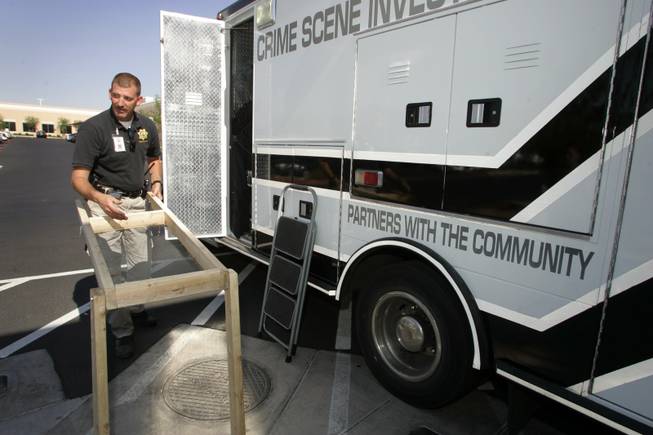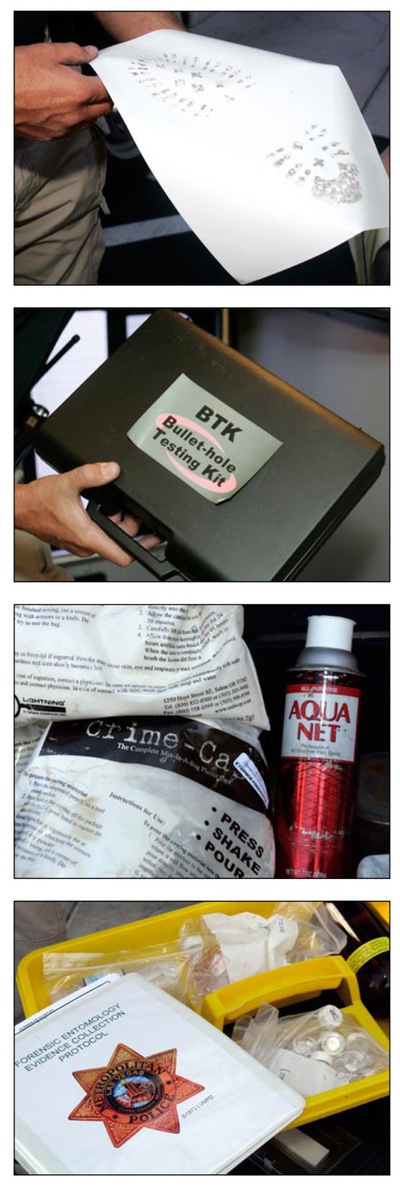
Crime Scene Analyst Supervisor Jeff Smink shows off a homemade dirt sifter next to Metro’s crime scene investigation truck Wednesday. The sifter is used for sorting through soil to find bones, or bullet casings, or whatever clues get lost in the dirt after a homicide. When the sifter gets too grungy, it’s tossed.
Tuesday, July 8, 2008 | 2 a.m.
Sun Archives
Up until seven months ago, if there was a homicide somewhere in Clark County, Metro’s crime scene investigators would pile into an RV — the kind your grandparents dream of driving across the country, but a little more beat up — and head to the scene like it was some kind of creepy family trip, the cabinets stocked with body fluid test kits instead of hamburger buns.
It went on this way until Jeff Smink, crime scene analyst supervisor for the department, got word that Las Vegas Fire & Rescue was getting rid of an emergency response truck — an ambulance on steroids, really. Smink figured it might make a good replacement for his section’s brown behemoth RV.
He spent months working out the donation between departments, and in December he got cash-strapped Metro a new major crime response vehicle for nothing. The department painted it skunk black and white, ran the Metro logo along the side in 1,000-point type, and stuffed it with CSI gear, high- and low-tech alike.
Now it’s a truck you don’t want to see coming up your driveway.
The crime lab on wheels responds mainly to homicides and officer-involved shootings. And outside of a crime scene, it’s hard to get a tour of the truck. The first time the Sun tried, Smink had to cut the interview off after minutes so he could make his way to a murder. It’s an everyday occurrence: At any given time, there are four to seven crime scene analysts to cover the 7,560 square miles of Metro’s jurisdiction, and with major crimes happening almost every day, and often more than once a day, getting Smink to unpack the truck takes patience.
But it’s worth it. There’s a reason this nation of TV watchers salivates for shows that expose the secrets of CSI. No matter how fantastically inflated, the basic science that informs every crime scene show is, in a word, nifty. And even better: It’s also a little gross.
Metro’s new crime truck is chock-full of swabs and lasers and chemicals and endless boxes of plastic gloves. But this is just the beginning.
Of the hundreds of items tucked into every corner of the truck, some are a bit cooler than others. Here are 10 things you will find in Metro’s crime truck on any given day, if you’re lucky enough, or maybe that’s unlucky enough, to see inside:
1. Aqua Net
Metro uses the heavy-hold hair spray to preserve the shape of tire tracks or footprints that could crumble in the dirt. The aerosol can blasts a tacky film that coats the ridges and valleys of an impression, holding it stiff the way it would a big bouffant.
2. Electrostatic Dust Print Lifter
This machine manufactures static electricity, which is transferred to a sheet of Mylar, so that it grabs dust the way a balloon rubbed against the head attracts hair. When the static-charged Mylar is set atop a dusty print, like what might be left behind on a kicked-in door, or on a vinyl car seat, the dust image is transferred onto the sheet and photographed.
3. Crime Cast
A package of white add-water molding material, kind of like the dentist uses, for capturing casts: footprints to bite marks. The Crime Cast brand preferred by Metro is wrapped with a slogan that sounds like as sales pitch for add-water cake: “No more mixing bowls! No more measuring! No more mess!”
4. Forensic entomology evidence collection kit
Bugs found on a dead body can answer questions about a crime. Metro CSI technicians collect two kinds: living and dead. Forensic entomologists let the living bugs grow until they can identify the species, then use that information to assess the dead bugs’ relative age, which helps determine how long the person has been dead. If maggots are present, scientists can extract information about what the bugs have ingested: A murder victim’s toxicology or DNA type. To do this test, they must blend the bugs together — a maggot milkshake.
5. Dirt sifter
Metro CSIs make their own dirt sifter — a standing table of sorts, with two-by-fours for legs and a mesh screen top. This is for sorting through soil to find bones, or bullet casings, or whatever clues get lost in the dirt after a homicide. If the sifter gets too grimy or gory, Smink says, they throw it away and build a new one.
6. Luminol
When it seems like a crime scene has been cleaned up, Metro CSI technicians use Luminol, a chemical that fluoresces when it comes into contact with the iron in blood. The chemical reaction lasts just long enough for investigators to photograph the glowing neon blue in a dark room. Trace amounts of blood can be uncovered, even after a thorough cleanup, so Smink wants the world to know: “You’ll never be able to get rid of all the blood.”
7. Enough brand-new bedsheets to equip a small Motel 6
Technicians wrap the bedsheets around a body before transferring it to the morgue to maintain any trace evidence that would get lost in a body bag. Same with “preservation bags,” small sacks that are slipped over the hands so evidence — revealing residues, bodily fluids, anything stuck under a victim’s fingernails — is preserved.
8. Piles of powder
Red Blitz, Ultra Blue, Lightning White, Black Ruby Fluorescent and Redwop are, despite the jazzed-up names, pretty basic fingerprinting powders — and there are several, with different colors and chemical compounds for different occasions. Redwop (that’s powder backward, by the way) was the first powder to luminesce. Now it’s part of any CSI technician’s basic kit. Depending on what kind of surface you’re working with, and what kind of print, Metro CSI analysts have a paint palette of powders.
9. Bullet hole testing kit
This is one of the crime scene investigators’ newer toys, though they would cringe to hear it called that. It allows them to test a hole for chemical residues that can indicate not only whether it’s the result of a bullet, but what kind of bullet it was: full-metal jacket, lead, etc. Moreover, the chemical detection process can help CSI technicians determine in what direction a bullet was moving and other things, like whether the slug merely skidded past a wall en route to somewhere else.
10. Buccal swabs
Like long Q-tips, but with a soft, saw-toothed edge, buccal swabs are for scraping down the sides of the mouth, sloughing off epithelial cells so they can be tested for DNA. This is a classic scene in any TV crime drama, a bad guy nabbed with a single swab of the cheek. Except in real life it can take weeks or even months to do the testing. Smink, who doesn’t watch any of those shows, puts it like this: “You can’t do a DNA profile during a commercial break.”


Join the Discussion:
Check this out for a full explanation of our conversion to the LiveFyre commenting system and instructions on how to sign up for an account.
Full comments policy